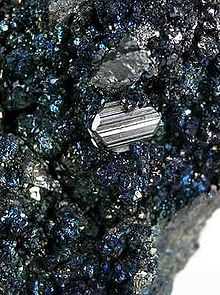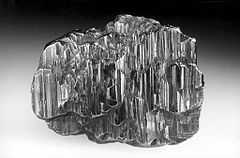Andorite
| Andorite | |
|---|---|
|
Andorite - Itos Mine, Oruro City, Cercado Province, Bolivia. Specimen height is 4.1 cm. | |
| General | |
| Category | Sulfosalt mineral |
| Formula (repeating unit) | PbAgSb3S6 |
| Strunz classification | 02.JB.40a |
| Crystal symmetry | Orthorhombic (2/m 2/m 2/m) dipyramidal |
| Unit cell | a = 12.99 Å, b = 19.14 Å, c = 4.3 Å; Z = 4 |
| Identification | |
| Color | Dark steel-gray, may tarnish yellow or iridescent; white in polished section |
| Crystal habit | Crystals stout prismatic to tabular on {100}, striations parallel to [001]; massive |
| Crystal system | orthorhombic |
| Twinning | On {110} |
| Cleavage | none observed |
| Fracture | conchoidal |
| Mohs scale hardness | 3 - 3.5 |
| Luster | metallic |
| Streak | Black |
| Diaphaneity | Opaque |
| Specific gravity | 5.33 - 5.37 |
| Optical properties | anisotropic |
| References | [1][2] |
Andorite is a sulfosalt mineral with the chemical formula PbAgSb3S6.
It was first described in 1892 for an occurrence in the Baia Sprie mine, Baia Sprie, Maramures County, Romania, and named for Hungarian amateur mineralogist Andor von Semsey (1833–1923).[1] [3] Andorite occurs in low-temperature polymetallic hydrothermal veins. It occurs associated with stibnite, sphalerite, baryte, fluorite, siderite, cassiterite, arsenopyrite, stannite, zinkenite, tetrahedrite, pyrite, alunite, quartz, pyrargyrite, stephanite and rhodochrosite.[2]

Sharp crystals of andorite (to 7 mm) with stannite matrix, San José Mine, Oruro Department, Bolivia
References
- ↑ 1.0 1.1 "Andorite: Mindat mineral information and data.". 2010. Archived from the original on 21 January 2010. Retrieved 2/04/10. Check date values in:
|accessdate=(help) - ↑ 2.0 2.1 Handbook of Mineralogy
- ↑ "Andorite Mineral Data". 2010. Archived from the original on 17 January 2010. Retrieved 2/04/10. Check date values in:
|accessdate=(help)
